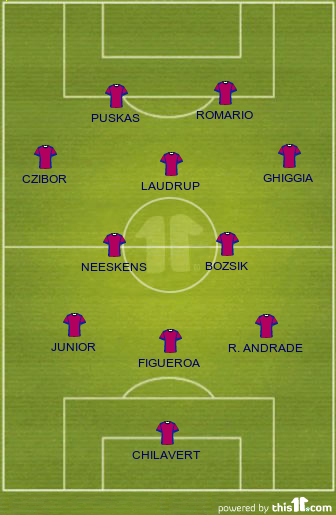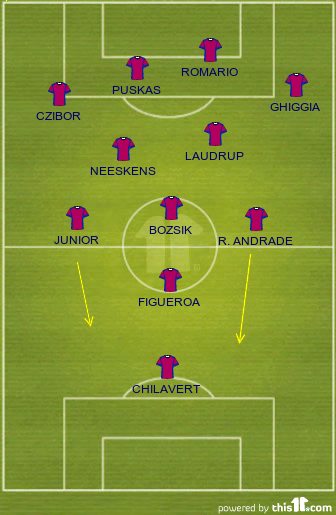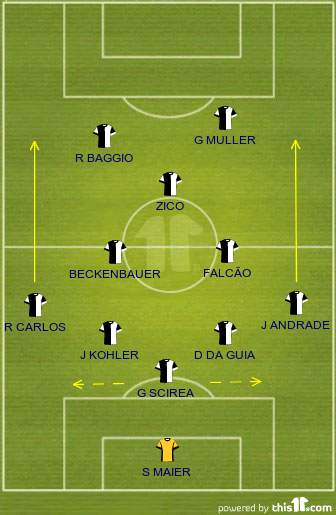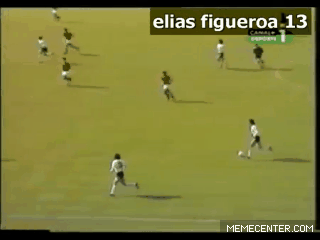Polaroid
New Member
- Joined
- Dec 17, 2003
- Messages
- 2,703
The aim of this poll is to decide who will come up victorious in a hypothetical match between the two teams. ONLY THE PRIME WORLD CUP FORM OF THE PLAYERS IN QUESTION IS CONSIDERED. CLUB FORM IS COMPLETELY IRRELEVANT.

Interesting, I know, which is why you should read below because it is all about tactics.
Theon has a cracking assortment of players, no doubt. If I gave them the entire pitch to play in, I would be in a spot of bother. His problem though is the lack of pace upfront, there’s no Eusebio, Ronaldo, Romario, or any pacey winger for me to worry about, so I can deploy the Magnificent Magyar’s tactics*, with the right personnel for them, and push up and into his half. If he recovers possession I don’t have to worry about pace on the break and thus the long ball over the top which was the Achilles heel of that side. Figueroa, Junior, Andrade and Chilavert as sweeper-keeper can handle that.

Conversely, in Romario I have arguably the best ever at running off the shoulder of the last defender, which calls for Theon to defend deep (which he has to anyway as Da Guia ‘38 would be terribly confused by the modern offside trap), leaving space between the lines for me to let my play unfold when I recover possession. The explosive power in Romario, Czibor and Ghiggia, means I stretch him along and across the pitch, something which he is ill-suited to do.
The total sum of that is I can play my game and he can’t get into a rhythm. It also means I can put him through periods of sustained pressure, but also hit him on the break. Basically, whichever way the game unfolds, I have the means to hurt him, while his setup is one where you would hope to score first and nick a 1-0 win.
How the game will unfold:
As he gets onto the pitch, Roberto Carlos sees Puskas and repeats the infamous words: "Look at that little fat chap. We'll murder this lot". Beckenbauer is a wee bit more concerned as he looks around and his maths doesn’t add up: “Where’s Cannavaro?”, he asks himself as the whistle blows for kick off.
Total confusion ensues as the Magyars + Neeskens + the proven Dream Team combo of Romario and Laudrup unleash total football on Theon’s team. They really hadn’t prepared for this at all.
Within 10 minutes, Puskas has scored and in the remainder of the first half they engage in desperate damage limitation at the Underdogs’ swarming approach. They still concede to a beautiful chip by Laudrup finding “O Baixinho” inside the box. 2-0.
At half-time, the disgruntled players go back to their managers for direction. “What the flying feck was that?”, says one of them. Theon and Snow apply themselves to how to turn it around, how to get at that three man defence better, shame Piola has flown back home after being told by his manager that he couldn’t hack it at this level...
With renewed confidence, they come back to the pitch for the second half, only to find this in front of them:


They toil away trying to get back in the game, but for every chance they get there’s an equally good chance the Underdogs get on the break. They finally claw one back, but only five minutes later Ghiggia is again scampering down the wing unchallenged, Kohler doesn’t get there in time to avoid the cross, and Romario scores with a deft touch, Brazil-Netherlands ’94 style.
3-1, game over. There may be time for a second, but that’s all they will get.
*Magnificent Magyar tactics explained
Hungary's problem in the 1950s was the centre-forward. Along with the W-M came the brawny centre-forward, which is what the Hungarian team did not have in 1953. Gustav Sebes, the 1953 coach of the Hungarian national team, changed the W-M to a W-W in the following manner:
He pulled the centre-forward back to play as a playmaker, taking over the role of the two inside-forwards (Laudrup instead of Hidegkuti). They were instead pushed up to give Hungary a two-pronged strikeforce (Puskas and Romario instead of Kocsis). The wingers were pulled back to give a 5-man midfield (Czibor and Ghiggia instead of Budai, both tracking and pressing).
Hungary's national team also attacked as a unit, with the backline moving into the opposing half. This adventurous play was open to counterattacks, via a long ball over the desperately out-of-place defence and speedy forwards (absent in the opposition). But the likelihood of this was lessened by the even more adventurous play of goalkeeper Gyula Grosics, who often came out of the 18-yard box to clear loose balls (Chilavert).
Advice on the W-W: If the W-W is to be used successfully, you need two centre-forwards, one playmaker, and two very good runners who can play up and down the wing. This is for the forward line.(Check) For the defensive W you need to have five alert players who can run well, have plenty of stamina and pass well (Junior and Andrade fit the bill alongside Figueroa, Neeskens and their original DLP in Bozsik).
More on the Aranycsapat (“Golden Team”)
The Hungarian football team of the 1950’s redefined the sport of soccer, revolutionising the way the game was approached and breaking records by the bucket load. Between June 1950 and the Hungarian Revolution in 1956 the Magnificent Magyars compiled a competitive record of forty-two wins, seven draws and only one defeat. The tragedy is that the defeat came in the final of the 1954 World Cup.
Rarely has a single national side been blessed with as many truly world class players inhabiting a single era. Yet Hungary during the 1950’s could call upon the services of a plethora of international stars. The incomparable Ferenc Puskas, arguably the greatest goalscorer in the history of the modern game, with 84 goals in 85 games, captained the team.
His strike partner was the equally predatory Sandor Kocsis, a forward whose 75 international goals were plundered in only 68 matches. Completing the triumvirate of attacking geniuses was the deep-lying centre forward Nandor Hidegkuti (39 goals in 69 games), the last man to score a hat trick against England at Wembley, way back in 1953.
Aside from the strikers Hungary could call on the services of two other genuinely world class talents. Jozef Bozsik in central midfield was the schemer and playmaker, the man who loaded the bullets for the strike force to fire. On the wing the mobile and visionary Zoltan Czibor epitomised the speedy and skilful wide player. Quite simply no other team in the international arena could match the Hungarian juggernaut over an unbeaten run.
All my players made the FIFA All-Star Team in at least one World Cup, you can read more on them here:
PLAYER PROFILES

Interesting, I know, which is why you should read below because it is all about tactics.
Theon has a cracking assortment of players, no doubt. If I gave them the entire pitch to play in, I would be in a spot of bother. His problem though is the lack of pace upfront, there’s no Eusebio, Ronaldo, Romario, or any pacey winger for me to worry about, so I can deploy the Magnificent Magyar’s tactics*, with the right personnel for them, and push up and into his half. If he recovers possession I don’t have to worry about pace on the break and thus the long ball over the top which was the Achilles heel of that side. Figueroa, Junior, Andrade and Chilavert as sweeper-keeper can handle that.

Conversely, in Romario I have arguably the best ever at running off the shoulder of the last defender, which calls for Theon to defend deep (which he has to anyway as Da Guia ‘38 would be terribly confused by the modern offside trap), leaving space between the lines for me to let my play unfold when I recover possession. The explosive power in Romario, Czibor and Ghiggia, means I stretch him along and across the pitch, something which he is ill-suited to do.
The total sum of that is I can play my game and he can’t get into a rhythm. It also means I can put him through periods of sustained pressure, but also hit him on the break. Basically, whichever way the game unfolds, I have the means to hurt him, while his setup is one where you would hope to score first and nick a 1-0 win.
How the game will unfold:
As he gets onto the pitch, Roberto Carlos sees Puskas and repeats the infamous words: "Look at that little fat chap. We'll murder this lot". Beckenbauer is a wee bit more concerned as he looks around and his maths doesn’t add up: “Where’s Cannavaro?”, he asks himself as the whistle blows for kick off.
Total confusion ensues as the Magyars + Neeskens + the proven Dream Team combo of Romario and Laudrup unleash total football on Theon’s team. They really hadn’t prepared for this at all.
Within 10 minutes, Puskas has scored and in the remainder of the first half they engage in desperate damage limitation at the Underdogs’ swarming approach. They still concede to a beautiful chip by Laudrup finding “O Baixinho” inside the box. 2-0.
At half-time, the disgruntled players go back to their managers for direction. “What the flying feck was that?”, says one of them. Theon and Snow apply themselves to how to turn it around, how to get at that three man defence better, shame Piola has flown back home after being told by his manager that he couldn’t hack it at this level...
With renewed confidence, they come back to the pitch for the second half, only to find this in front of them:


They toil away trying to get back in the game, but for every chance they get there’s an equally good chance the Underdogs get on the break. They finally claw one back, but only five minutes later Ghiggia is again scampering down the wing unchallenged, Kohler doesn’t get there in time to avoid the cross, and Romario scores with a deft touch, Brazil-Netherlands ’94 style.
3-1, game over. There may be time for a second, but that’s all they will get.
*Magnificent Magyar tactics explained
The W-W(1953)


Hungary's problem in the 1950s was the centre-forward. Along with the W-M came the brawny centre-forward, which is what the Hungarian team did not have in 1953. Gustav Sebes, the 1953 coach of the Hungarian national team, changed the W-M to a W-W in the following manner:
He pulled the centre-forward back to play as a playmaker, taking over the role of the two inside-forwards (Laudrup instead of Hidegkuti). They were instead pushed up to give Hungary a two-pronged strikeforce (Puskas and Romario instead of Kocsis). The wingers were pulled back to give a 5-man midfield (Czibor and Ghiggia instead of Budai, both tracking and pressing).
Hungary's national team also attacked as a unit, with the backline moving into the opposing half. This adventurous play was open to counterattacks, via a long ball over the desperately out-of-place defence and speedy forwards (absent in the opposition). But the likelihood of this was lessened by the even more adventurous play of goalkeeper Gyula Grosics, who often came out of the 18-yard box to clear loose balls (Chilavert).
Advice on the W-W: If the W-W is to be used successfully, you need two centre-forwards, one playmaker, and two very good runners who can play up and down the wing. This is for the forward line.(Check) For the defensive W you need to have five alert players who can run well, have plenty of stamina and pass well (Junior and Andrade fit the bill alongside Figueroa, Neeskens and their original DLP in Bozsik).
More on the Aranycsapat (“Golden Team”)
The Hungarian football team of the 1950’s redefined the sport of soccer, revolutionising the way the game was approached and breaking records by the bucket load. Between June 1950 and the Hungarian Revolution in 1956 the Magnificent Magyars compiled a competitive record of forty-two wins, seven draws and only one defeat. The tragedy is that the defeat came in the final of the 1954 World Cup.
Rarely has a single national side been blessed with as many truly world class players inhabiting a single era. Yet Hungary during the 1950’s could call upon the services of a plethora of international stars. The incomparable Ferenc Puskas, arguably the greatest goalscorer in the history of the modern game, with 84 goals in 85 games, captained the team.
His strike partner was the equally predatory Sandor Kocsis, a forward whose 75 international goals were plundered in only 68 matches. Completing the triumvirate of attacking geniuses was the deep-lying centre forward Nandor Hidegkuti (39 goals in 69 games), the last man to score a hat trick against England at Wembley, way back in 1953.
Aside from the strikers Hungary could call on the services of two other genuinely world class talents. Jozef Bozsik in central midfield was the schemer and playmaker, the man who loaded the bullets for the strike force to fire. On the wing the mobile and visionary Zoltan Czibor epitomised the speedy and skilful wide player. Quite simply no other team in the international arena could match the Hungarian juggernaut over an unbeaten run.
All my players made the FIFA All-Star Team in at least one World Cup, you can read more on them here:
PLAYER PROFILES
Last edited:




